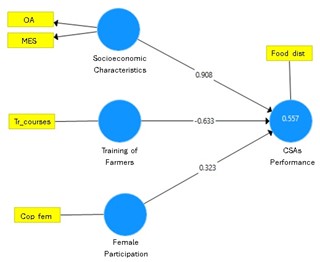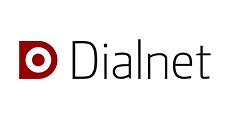
Publicado
Structure of the production module, production factors and economic performance in Brazilian coffee growth
Estructura del módulo de producción, factores de producción y desempeño económico en el crecimiento del café brasileño
DOI:
https://doi.org/10.15446/dyna.v91n234.113044Palabras clave:
coffee, agribusiness, structural equation modeling (en)café, agronegocios, modelos de ecuaciones estructurales (es)
Descargas
Coffee growing is an important activity for Brazilian agribusiness, and several production factors can reflect on economic and productive results. In this sense, the objective of this work was to evaluate, through Structural Equation Modeling, the interactions between property structure and effective operational costs with productivity, product value, and economic performance for coffee growing in Brazil. It was observed that the property structure positively influences productivity, but the hypotheses that they influence product value and economic performance were not validated. As for the effective operating costs, it was only possible to affirm a negative influence on financial performance. In this way, the study contributes to the formation of strategies among producers as well as providing theoretical support on the applicability of the structural equation modeling technique. Finally, it is suggested the use of new managerial indicators to measure economic performance, the evaluation of the impact of coffee beverage quality on costs and ownership structure, in addition to replicating the study for other crops such as oranges, apples, bananas, and papaya.
El cultivo de café es una actividad importante para la agroindustria brasileña y existen varios factores de producción que pueden reflejarse en los resultados económicos y productivos. En este sentido, el objetivo de este trabajo fue evaluar, a través del Modelo de Ecuaciones Estructurales, las interacciones entre la estructura de propiedad y los costos operativos efectivos con la productividad, el valor del producto y el desempeño económico del cultivo de café en Brasil. Se observó que la estructura de propiedad influye positivamente en la productividad, pero no se validaron las hipótesis de que influyen en el valor del producto y el desempeño económico. En cuanto a los costos operativos efectivos, sólo se pudo afirmar una influencia negativa en el desempeño económico. De esta manera, el estudio contribuye a la formación de estrategias entre los productores, así como brindar sustento teórico sobre la aplicabilidad de la técnica de modelación de ecuaciones estructurales. Finalmente, se sugiere el uso de nuevos indicadores gerenciales para medir el desempeño económico, la evaluación del impacto de la calidad de la bebida de café en los costos y la estructura de propiedad, además de replicar el estudio para otros cultivos como naranja, manzana, plátano y papaya.
Referencias
[1] CEPEA. Perspectivas para o agronegócio em 2022. Centro de Estudos Avançados em Economia Aplicada - CEPEA-Esalq/USP. [online]. 2022. [Accessed: September 15th 2024]. Available at: https://www.cepea.esalq.usp.br/br/opiniao-cepea/perspectivas-para-o-agronegocio-em-2022.aspx.
[2] CNA BRASIL. PIB do agronegócio tem crescimento recorde de 24,31% em 2020. Confederação da Agricultura e Pecuária do Brasil (CNA). [online]. 2022. [Accessed: September 15th 2024]. Available at: https://www.cnabrasil.org.br/noticias/pib-do-agronegocio-tem-crescimento-recorde-de-24-31-em-2020 0.
[3] Ben-Amara, D., Chen, H., and Hafeez, M., Role of entrepreneurial opportunity identification factors in the eco‐innovation of agribusiness. Business Strategy & Development, 3(4), pp. 435-448, 2020. DOI: https://doi.org/10.1002/bsd2.107
[4] Samoggia, A., and Riedel, B., Coffee consumption and purchasing behavior review: Insights for further research. Appetite, 129, pp. 70-81. 2018. DOI: https://doi.org/10.1016/j.appet.2018.07.002
[5] CONAB, National Supply Company. Monitoring the Brazilian coffee crop, v. 6 – 2020, Harvest no. 4 - fourth survey, Brasília. 2020.
[6] CONAB, National Supply Company. Monitoring of Brazilian crop – coffee; Second estimate – 2013 Harvest. Brasília, 2013.
[7] CONAB. Conab - Safra Brasileira de Café. Conab - Página inicial. [online]. 2022. [Accessed: September 15th 2024]. Available at: https://www.conab.gov.br/info-agro/safras/cafe.
[8] Council of coffee exporters from Brazil – Cecafé. Annual export. [online]. 2021. [Accessed: February 08th 2024]. Available at: https://www.cecafe.com.br/dados-estatisticos/exportacoes-brasileiras/
[9] CNN Brasil. Mudanças climáticas podem afetar produção de café no Brasil, diz estudo. CNN Brasil. [online]. 2022. [Accessed: February 08th 2024]. Available at: https://www.cnnbrasil.com.br/business/mudancas-climaticas-podem-afetar-producao-de-cafe-no-brasil-diz-estudo/.
[10] Shim, J.M., Lee, W.S., Moon, J., and Song, M., Coffee shop corporate social responsibility (CSR) and reuse intention using triple bottom line theory. British Food Journal, 123(12), pp. 4421-4435, 2021. DOI: https://doi.org/10.1108/BFJ-12-2020-1134
[11] Ntiamoah, E.B., Li, D., and Sarpong, D.B., The effect of innovation practices on agribusiness performance: a structural equation modelling (SEM) approach. African Journal of Science, Technology, Innovation and Development, [online]. 11(6), pp. 671-681, 2019.Available at: https://hdl.handle.net/10520/EJC-18b0b25690 DOI: https://doi.org/10.1080/20421338.2019.1573958
[12] Viana, J.G.A., and Silveira, V.C.P., Production costs and performance indicators: a methodology applied to sheep production systems. CEP, 90050, 2008, 230 P.
[13] dos Santos, P.M., Cirillo, M.Â., and Guimaraes, E.R., Specialty coffee in Brazil: transition among consumers' constructs using structural equation modeling. British Food Journal. 123(5), pp. 1913-1930, 2021. DOI: https://doi.org/10.1108/BFJ-06-2020-0537
[14] Lampert, J.A., Rural administration textbook. In: Rural Administration. Santa Maria: DEAER/UFSM. 2003.
[15] Safras & Cifras. Curso de gerenciamento econômico na agropecuária. FARSUL/SENAR. Rio Pardo, Brasil, 1997.
[16] Matsunaga, M., Bemelmans, P.F., Toledo, P.D., Dulley, R.D., Okawa, H., and Pedroso, I.A., Metodologia de custo de produção utilizada pelo IEA. Agricultura em São Paulo, 23, pp. 123-139, 1976.
[17] Martin, N.B., Serra, R., Oliveira, M.D.M., Ângelo, J.A., and Okawa, H., Integrated system of agricultural and livestock costs-Custagri. Inf. Econ., 28, pp. 7-28, 1998. DOI: https://doi.org/10.1287/inte.28.4.38
[18] Lima, A.L.R. et al., Production costs: the impact of productivity on coffee growing results in the main producing regions in Brazil, 2008.
[19] Mariyono, J., Improvement of economic and sustainability performance of agribusiness management using ecological technologies in Indonesia. International Journal of Productivity and Performance Management. 69(5), pp. 989-1008, 2019. DOI: https://doi.org/10.1108/IJPPM-01-2019-0036
[20] Van Waeyenberg, T., Peccei, R., and Decramer, A., Performance management and teacher performance: the role of affective organizational commitment and exhaustion. The International Journal of Human Resource Management, 33(4), pp. 623-646, 2022. DOI: https://doi.org/10.1080/09585192.2020.1754881
[21] Suárez, A.E., Gutiérrez-Montes, I., Ortiz-Morea, F.A., Suárez, J.C., Di Rienzo, J., and Casanoves, F., Contribution of livelihoods to the well-being of coffee-growing households in southern Colombia: a structural equation modeling approach. Sustainability, 14(2), art. 743, 2022. DOI: https://doi.org/10.3390/su14020743
[22] Pronti, A., and Coccia, M., Multicriteria analysis of the sustainability performance between agroecological and conventional coffee farms in the East Region of Minas Gerais (Brazil). Renewable Agriculture and Food Systems, 36(3), pp. 299-306, 2021. DOI: https://doi.org/10.1017/S1742170520000332
[23] Izquierdo, N.V., Lezama, O.B.P., Dorta, R.G., Viloria, A., Deras, I., and Hernández-Fernández, L., Fuzzy logic applied to the performance evaluation. Honduran coffee sector case. In: International Conference on Swarm Intelligence Springer, Cham. 2018, pp. 164-173. DOI: https://doi.org/10.1007/978-3-319-93818-9_16
[24] Gosal, G.G., Christian, T.F., and Filbert, V., The Relationship between sensory marketing, packaging, and purchasing decisions. A study of coffesia's coffee product. 2020. DOI: https://doi.org/10.18502/kss.v5i5.8814
[25] Cruz-Correia, P.F.D., Reis, J.G.M.D., Toloi, R.C., Araújo, F.A.D., Bonilla, S.H., Souza, J.S.D., ... and Souza, A.E.D., Economic and environmental perfomance in coffee supply chains: a Brazilian Case study. In: IFIP International Conference on Advances in Production Management Systems Springer, Cham. 2020, pp. 631-639. DOI: https://doi.org/10.1007/978-3-030-57997-5_73
[26] Oliveira, E. de et al., Influence of mechanized harvesting on coffee production. Rural Science, 37, pp. 1466-1470, 2007. DOI: https://doi.org/10.1590/S0103-84782007000500041
[27] Marsh, H.W., Morin, A.J., Parker, P.D., and Kaur, G., Exploratory structural equation modeling: an integration of the best features of exploratory and confirmatory factor analysis. Annual review of clinical psychology, 10, pp. 85-110, 2014. DOI: https://doi.org/10.1146/annurev-clinpsy-032813-153700
[28] Tripathi, K.K., and Jha, K.N., Determining success factors for a construction organization: a structural equation modeling approach. J. Manage. Eng, 34(1), art. 04017050, 2018. DOI: https://doi.org/10.1061/(ASCE)ME.1943-5479.0000569
[29] Chandio, F.H., Studying acceptance of online banking information system: a structural equation model. Doctoral dissertation, Brunel University Brunel Business School, United Kingdom, 2011.
[30] Mueller, R.O., and Hancock, G.R., Structural equation modeling. In: The reviewer’s guide to quantitative methods in the social sciences. Routledge. 2018, pp. 445-456. DOI: https://doi.org/10.4324/9781315755649-33
[31] Hair, J.F., Ringle, C.M., and Sarstedt, M., PLS-SEM: Indeed a silver bullet. Journal of Marketing theory and Practice, 19, pp. 139-152, 2011. DOI: https://doi.org/10.2753/MTP1069-6679190202
[32] Zhang, H., Structural equation modeling. In: Models and Methods for Management Science, Springer, Singapore, 2022, pp. 363-381. DOI: https://doi.org/10.1007/978-981-19-1614-4_10
[33] Civelek, M.E., Essentials of structural equation modeling. Essentials of Structural Equation Modeling, 2018. DOI: https://doi.org/10.13014/K2SJ1HR5
[34] Oliveira, R.R., Marinho-Marlon, F.A., and Days, A.T., A study on the use of structural equation modeling in scientific production in the areas of administration and information systems. Journal of Administration of the Federal University of Santa Maria, 9, pp. 559-578, 2016.
[35] Perry, J.L., Nicholls, A.R., Clough, P.J., and Crust, L., Assessing model fit: caveats and recommendations for confirmatory factor analysis and exploratory structural equation modeling. Measurement in physical education and exercise science, 19, pp. 12-21, 2015. DOI: https://doi.org/10.1080/1091367X.2014.952370
[36] Bagozzi, R.P., and Yi, Y., Specification, evaluation, and interpretation of structural equation models. Journal of the Academy of Marketing Science, 40, pp. 8-34, 2012. DOI: https://doi.org/10.1007/s11747-011-0278-x
[37] Wan-Omar, W.A., and Hussin, F., Transformational leadership style and job satisfaction relationship: a study of structural equation modeling (SEM). International Journal of Academic Research in Business and Social Sciences (IJARBSS), 3, pp. 346-365, 2013.
[38] Pandey, P., and Pandey, M.M., Research methodology tools and techniques, Bridge Center, 2021.
[39] Dźwigoł, H., and Dźwigoł-Barosz, M., Scientific research methodology in management sciences. Financial and credit activity problems of theory and practice, 2(25), pp. 424-437, 2018. DOI: https://doi.org/10.18371/fcaptp.v2i25.136508
[40] SEBRAE. Como conservar o solo na produção de café. [online]. 2022. [Accessed: September 15th 2024]. Available at: https://www.sebrae.com.br/sites/PortalSebrae/artigos/como-conservar-o-solo-na-producao-de-cafe,a40b9e665b182410VgnVCM100000b272010aRCRD. Accessed: 15 set. 2024.
[41] Hasibuan, A.M., Ferry, Y., and Wulandari, S., Factors affecting farmers’ decision to use organic fertilizers on Robusta coffee plantation: a case study in Tanggamus, Lampung. In: IOP Conference Series: Earth and Environmental Science, 974(1), art. 012105, IOP Publishing, 2022. DOI: https://doi.org/10.1088/1755-1315/974/1/012105
[42] Nzeyimana, I., Hartemink, A.E., and de Graaff, J., Coffee farming and soil management in Rwanda. Outlook on Agriculture, 42(1), pp. 47-52, 2013. DOI: https://doi.org/10.5367/oa.2013.0118
[43] Cerrado Mineiro (Brasil). A Região do Cerrado Mineiro. [online]. 2022. [Accessed: December 22th 2024]. Available at: https://www.cerradomineiro.org/index.php?pg=home.
[44] Camargo, M.B.P.D., The impact of climatic variability and climate change on arabic coffee crop in Brazil. Bragantia, 69, pp. 239-247, 2010. DOI: https://doi.org/10.1590/S0006-87052010000100030
[45] Pham, Y., Reardon-Smith, K., Mushtaq, S., and Cockfield, G., The impact of climate change and variability on coffee production: a systematic review. Climatic Change, 156(4), pp. 609-630, 2019. DOI: https://doi.org/10.1007/s10584-019-02538-y
[46] Reis, R.P., Reis, A.J.D., Fontes, R.E., Takaki, H.R.C., and Castro Júnior, L.G.D., Custos de produção da cafeicultura no sul de Minas Gerais, 2001. DOI: https://doi.org/10.22004/ag.econ.43360
[47] Cooxupé. Com altas puxadas pelos fertilizantes, custo de produção na cafeicultura está 50% mais elevado. [online]. 2022. [Accessed: December 22th 2024]. Available at: https://www.cooxupe.com.br/noticias/com-altas-puxadas-pelos-fertilizantes-custo-de-producao-na-cafeicultura-esta-50-mais-elevado/. Acesso em: 22 dez. 2020.
[48] Marques, I.R., Comparability of costs and prices in the cultivation of arabica and conilon coffee, 2021.
[49] Merle, I., Pico, J., Granados, E., Boudrot, A., Tixier, P., Virginio Filho, E.D.M., ..., and Avelino, J., Unraveling the complexity of coffee leaf rust behavior and development in different Coffea arabica agroecosystems. Phytopathology, 110(2), pp. 418-427, 2020. DOI: https://doi.org/10.1094/PHYTO-03-19-0094-R
[50] Ministério da Economia. Crédito rural. Ministério da Economia. [online]. 2022. Available at: https://www.gov.br/fazenda/pt-br/assuntos/politica-agricola-e-meio-ambiente/atuacao-spe/credito-rural
Cómo citar
IEEE
ACM
ACS
APA
ABNT
Chicago
Harvard
MLA
Turabian
Vancouver
Descargar cita
Licencia
Derechos de autor 2024 DYNA

Esta obra está bajo una licencia internacional Creative Commons Atribución-NoComercial-SinDerivadas 4.0.
El autor o autores de un artículo aceptado para publicación en cualquiera de las revistas editadas por la facultad de Minas cederán la totalidad de los derechos patrimoniales a la Universidad Nacional de Colombia de manera gratuita, dentro de los cuáles se incluyen: el derecho a editar, publicar, reproducir y distribuir tanto en medios impresos como digitales, además de incluir en artículo en índices internacionales y/o bases de datos, de igual manera, se faculta a la editorial para utilizar las imágenes, tablas y/o cualquier material gráfico presentado en el artículo para el diseño de carátulas o posters de la misma revista.
















